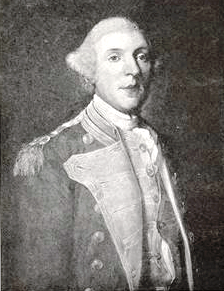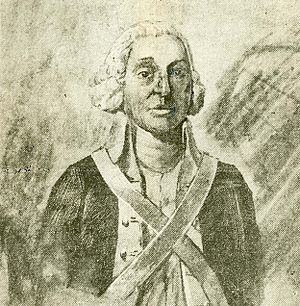Cape Sable campaign facts for kids
Quick facts for kids Cape Sable campaign |
|||||||
|---|---|---|---|---|---|---|---|
| Part of French and Indian War | |||||||
 Roger Morris By Benjamin West |
|||||||
|
|||||||
| Commanders and leaders | |||||||
|
|
||||||
| Units involved | |||||||
|
|||||||
The Cape Sable campaign was a military operation that happened in the fall of 1758. It was part of the French and Indian War. The British wanted to stop the Acadian people from helping the French. They planned to do this by moving the Acadians away from their homes.
Colonel Roger Morris led 325 British soldiers. Captain Joseph Gorham and his rangers, along with Rogers' Rangers, helped them. Their goal was to destroy Acadian settlements in what is now Shelburne County and Yarmouth County, Nova Scotia, Canada. This area was also known as Pobomcoup.
Why the Campaign Happened

The British took control of Acadia in 1710 after the Conquest of Acadia. For the next 45 years, the Acadians refused to promise their full loyalty to Britain. During this time, Acadians often helped fight against the British. They also kept important supply routes open for the French at places like Louisbourg and Fort Beausejour.
During the French and Indian War (1754–1758), the British decided to act. They wanted to remove any military threat from the Acadians. They also wanted to cut off the vital supplies the Acadians were sending to Louisbourg. So, they began to move the Acadians from their homes. This event is known as the deportations.
The first wave of these deportations started in 1755. It targeted areas like Beaubassin/Chignecto and Annapolis Royal. In April 1756, Major Jedidiah Preble and his New England troops raided Pubnico. Pubnico is in the Cape Sable region. They captured 72 Acadian men, women, and children.
The Campaign in Action
In September 1758, Colonel Robert Monckton sent Major Roger Morris to deport more Acadians. Morris was from the 35th Regiment. He commanded two warships and transport ships with 325 soldiers. They were on their way to another campaign at the St. John River.
On September 16, Morris and Captain Joseph Gorham landed near the mouth of the Bay of Saltponds River. This is thought to be the Argyle today. They started searching for Acadians but could not find anyone. So, on October 4, they began to burn Acadian farms.
On October 9, they found Father Jean-Baptiste de Gay Desenclaves. They also found 36 families, including 6 Mi'kmaq families. They were all held in the local church. On October 28, Monckton's troops sent the women and children to Georges Island. The men were kept behind and forced to destroy their own village. On October 31, the men were also sent to Halifax. About 130 Acadians and seven Mi'kmaq managed to escape.
In the spring of 1759, Major Erasmus James Philipps arranged for Gorham and his rangers to capture more Acadians. They took 151 Acadians prisoner. They arrived at Georges Island with them on June 29. These Acadians were then sent to Britain in November 1759. The remaining 100 Acadians and Mi'kmaq at Cape Sable fired upon Captain Silvanus Cobb in July 1759.
The Cape Sable region is one of only two places in Acadia where Acadian people lived before and after the Expulsion. The other place is Memramcook. Acadian families started to return to the Cape Sable area after 1767. Many of them are descendants of Philippe Mius d'Entremont, who founded Pobomcoup.

